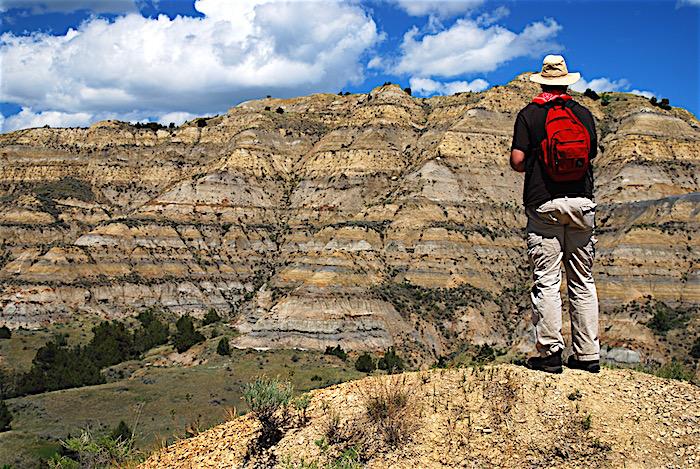
While Verizon Wireless will have its cell phone equipment on a new communication tower at Theodore Roosevelt National Park, the signal will not bleed into the park's officially designated wilderness/Kurt Repanshek file photo
A new communication tower is going up at the North Unit of Theodore Roosevelt National Park in North Dakota, and while Verizon Wireless will have equipment on the tower, it has been designed not to bleed a cell signal into official wilderness in the park.
The issue of a signal bleed was raised last fall by Public Employees for Environmental Responsibility, which worried that Verizon's signal from the tower would "blanket designated wilderness with cell phone coverage."
National Park Service staff recently issued a Final Environmental Assessment and Finding of No Significant Impact for the tower, which is a replacement. The current tower provides communication functions essential to public safety and efficient operations for the park and the U.S. Forest Service. The NPS will issue Verizon Wireless a right-of-way permit to co-locate their cellular equipment and replace the existing NPS communications tower northeast of the park entrance and east of U.S. 85.
Verizon Wireless initially proposed construction of a cellular communication tower on private lands near the park’s existing communication tower. The NPS and Verizon Wireless have determined that only one tower is needed to provide radio service to the NPS and USFS while providing cellular service for the U.S. 85 corridor. The new 190-foot high guyed tower will replace the existing 220 foot high guyed tower, eliminating the need for aviation safety lighting. Verizon Wireless will co-locate its telecommunications equipment on the tower and construct a slightly larger support shed to accommodate NPS, USFS, and Verizon equipment.
Park managers have successfully collaborated with companies in western North Dakota to reduce impacts to scenery, dark night skies, and natural sound.
“Verizon Wireless cooperated with the park to address concerns raised with the company’s proposal for installation of an additional communication tower near the park,” said Superintendent Wendy Ross. “The company’s willingness to work with the park in reducing light pollution and tower proliferation improves the North Unit visitor experience.”
Public comments during the EA review raised concerns about cellular phone service bleeding into designated wilderness areas, creating potential cell phone use conflicts between wilderness users. In response to these concerns, Verizon Wireless cellular equipment will only target the U.S. 85 corridor and will not provide additional cell service in designated wilderness areas.
The FONSI establishes that there would be no significant impact on the environment as a result of the selected action. The Final EA and the FONSI will be available through the NPS Planning



Comments
OK, Kurt. Satire is often in the eyes of the beholder, and I guess I beheld that a skosh bit differently than you. Life is good.
Precaution against what?
Yes, they are blanketing the wilderness with cell phone coverage. There still is not enough evidence that these signals are benign. There are studies out there that show effects of cell towers on life. Whatever happened to the precautionary principle? As for the other subject, wilderness allows you to be in the wild. when in the wild, anything can happen, and the inherent risk of that wildness is part of the experience. If you expect to be saved by a cell phone, you are not experiencing true wilderness. It is what I would call Disneyfied. People have a right to die. If you are worried about your life, then maybe you don't need to be in wilderness. We might as well allow mountain bikes in wilderness now.
This discussion is a perfect example of how the NPS -- and the rest of our government and society -- face an almost impossible challenge when it comes to serving ALL our citizens. That's why we sometimes have to trust people who have been elected or otherwise handed responsibility for managing our nation, our parks, indeed our world, to try to make the best decisions they can.
And having said that, No, I don't trust Congress because they respond to MONEY and not to good sense.
And no evidence it is dangerous.
https://www.cancer.org/cancer/cancer-causes/radiation-exposure/cellular-...
Besides, if it were dangerous what difference would it make that wilderness had no signal when the the areas you spend 99% of your time in do have signal.
What difference does it make when 99% of the Bear Valley Trail at Point Reyes is open to mountain biking, and the last 1/4 mile is wilderness and I can't take my bike? The fact that you ask that question seems to indicate you do not grasp what wilderness is.
ecbuck, The link you provided in your last post has this on the page;
"Public exposure to radio waves from cell phone tower antennas is slight for several reasons. The power levels are relatively low, the antennas are mounted high above ground level, and the signals are transmitted intermittently, rather than constantly."
they admitted that there is exposure. it may be slight for humans, but what about everything else?
Beside the fact I think you should be able to ride your bike in that last 1/4 mile your simile is flawed. A more accurate version would be if I can ride my bike 99% of the time in the Wilderness why can't I ride it the other 1%. In otherwords if damage is being done 99% of the time what difference dobes the other 1% make.
As to everything else? Bring on the evidence that anything else is threatened by RF waves.